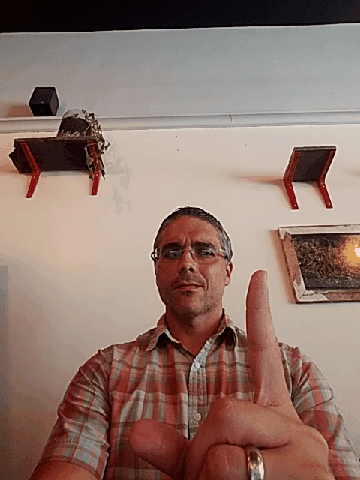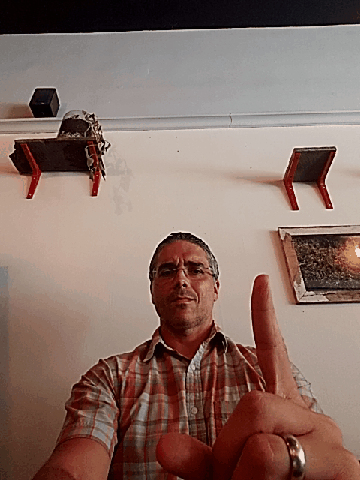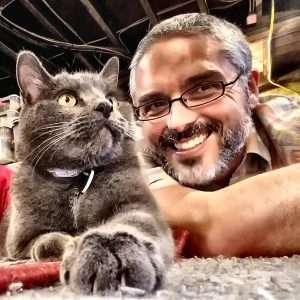My working title for this post was, “Embracing Inclusion, Culture, and Relationship: Relinquishing the Medical Model While Serving Neurodiverse Populations.”
Which is just like me. Extra. (And notice, I still had to share it.)
On a related note:
American Sign Language (ASL) contains a sign pair describing the general communication styles of Deaf people versus hearing people [i]. These two signs are identical but for one movement. The first sign, used to describe a “Deaf” communication style, requires that I put my non-dominant (in my case, left) hand up in front of me and extend my index finger…as if I’m indicating that I’m number one, or am pointing at something on the ceiling. Then, with my dominant right hand, I form a flat-palmed karate-chopping position. Finally, that right hand begins at the chest, mid-line, and travels directly at and touches the left finger [ii]

The implication is that the left finger represents “the point” and the right hand represents getting immediately and directly to it. In my past, having studied American Sign Language among Deaf people, dated several Deaf women, and served as a Deaf education Peace Corps volunteer in Kenya, my general experience meeting novel Deaf people went something like this:
Gregory: [Hi, I’m Gregory.]
New Deaf Person: [Oh, you know ASL?!]
Gregory: [I do!]
NDP: [Why are you interested in Deaf people?]
Right…to the point. Why is that? I don’t pretend to be an expert, historian, linguist, or, as I mentioned above, Deaf person. However, I have learned quite a bit through my research, endeavors, and experiences and know, as is the case with ANY cultural group, that there are both internal and external factors contributing to a stereotypical communicative style. For the sake of this post, I’m going to stick to one external piece of the equation. Specifically, many in the Deaf community harbor valid suspicion, if not outright (…and also justifiable…) distrust, of the hearing world [iii].
So, Deaf communication…is to the point, particularly when hearing people are involved.
On the other hand (the puns write themselves), the sign that describes the hearing world’s communication style starts the exact same way as its cognate, described above. My non-dominant left hand in front with index finger pointing up. Dominant right hand at chest in flat-palmed “karate chop” position. Now, instead of the shark’s fin, so to speak, travelling directly to the point, it waves right and left, back and forth, as it makes its way to the point.

Circumlocution. NOT…directly to the point. In the hearing world, our morays, politics, and social-rules are different and generally inform a circuitous route to the point.
We have that luxury.
More to the point, and to take full responsibility for my opinion, *I* have that luxury. I’m a white, hearing, and Standard American English speaking male. Furthermore, I can code switch to other dialects and even languages to assimilate or “fit in” to many contexts and communities outside of that massively mainstream and dominant cultural laundry list of demographics.
I’ll add several other terms here that describe me: non-disabled, generally, and non-Autistic, specifically.
I work and hang out with many Autistic children and young adults and individuals with neurodivergence. I don’t have Autism, but, much like my previous experiences within Deaf cultures, I often identify with and integrate into these communities. I live with anxiety, depression, and attentional challenges. That is, although I am non-disabled and non-Autistic, and although pharmaceutical and behavioral supports help me to function fairly seamlessly across my daily life, I am neurodivergent enough to have experiential access to empathy.
Here I’d like to break for a moment and explain two things.
First, I’m choosing the term “Autistic person” instead of “person with Autism.” In my experiences with Autistic and disabled people, I’ve learned that their preference is generally NOT person first language, which is demanded and standardized by ableist systems, institutions, and communities. I am making a conscious choice to listen to Autistic, Deaf, and disabled people and relinquish my paternalizing, pathologizing, western medical model training, behavior, and language.
Next, “neurodivergent.” This is a term I use to identify people who have not or can not assimilate to the demands of a neuroconvergent society. We so often, as human behavioral professionals, administrators, and power-wielders, demand that disabled people meet us 100% of the way. That is, we do not compromise. We require full assimilation or nothing. We exclude. Again, I reject this and embrace neurodivergence as nothing more, or less, than the factual existence of seemingly infinite diversity within our species. I choose to include without exception.
Thanks for that, now back to you regularly scheduled paragraph.
Analogous to the Deaf/hearing comparison, there are significant and generalizable differences in the communication styles of neuroconvergent and neurodivergent populations. In fact, those American Sign Language cognates from above would broadly fit these differences quite well. We neuroconvergents tend to talk around subjects, use indirect and abstract language, hints and metaphors, sarcasm and subtle non-verbal contributions that negate the actual message coming out of our mouths. We’re often politically correct (i.e. not quite saying what we mean for the sake of public-image preservation), and we spin information for a multitude of ends. Autistic and other neurodivergent folks tend to communicate directly, to the point, more literally than figuratively, less politically correct, minimizing spin for the sake of clarity.
So, what’s my point here?
(Remember, I’m hearing. And extra. Please forgive my meandering.)
There is a general difference between the ways that we in mainstream, majority, and “standard” cultural groups communicate and ways that those from fringe, minority, and non-standard cultural groups communicate. Sometimes that difference, as is the case with the Deaf/hearing comparison, is large to the point of completely different languages. And sometimes that difference, as is the case with the ASD/neurotyical comparison, is subtler and largely related to the social-pragmatic aspects of language.
The key word in that paragraph…is difference. Never, as a speech/language pathologist (SLP), did I indicate “disorder” (i.e. that something is wrong or pathological about said difference).
We human-behavior and health-related professionals almost always come from the majority/standard cultural perspective, and while serving individuals from minority/non-standards groups we generally use a medical approach. What does that mean? The medical model looks for anything that is different than what has been agreed upon by the dominant culture as “normal” and pathologizes it. We affix a diagnosis. Then, we say, in essence, “You’re broken, and I can fix you.” What happens, however, when a person doesn’t feel broken, doesn’t strive to be like everyone else, feels whole and fine and okay and then finds a community and then capitalizes that which we pathologize? When deaf becomes Deaf, when gay becomes Gay, when individual-with-Autism becomes Autistic, what do we do then?
As far as I can see, we tend to fight, cajole, legislate, dominate, and do everything but stop. And listen. And consider an alternative interaction style. A partnership of inclusion and compromise.
I’m nearly at my wit’s, mind’s, and heart’s end with the medical model, with our insistence on deeming everyone not like us “broken” and then “fixing” everyone not like us to be just like us…and I’m an SLP. I’ve been trained to think and act in precisely those ways with which I struggle.
So let me, the verbose, hearing, neuroconvergent-enough-to-pass (…some of you might validly argue that…) pathologist offer an alternative.
I would like to share with you one way I’ve modified my approach, and how that modification has changed nearly all of my relationships, including how I relate to myself, for the better.
Before I enter a service-oriented relationship with any person, I ask myself the very question that so many Deaf people asked me as I made my way through Peace Corps and beyond, “Why am I interested in this person?” “What is my goal?” “What do I want?” Then, I ask the person across from me the same questions. “What are you interested in me doing/saying?” “What are your goals?” “What do you want?”
And we move forward. In relationship.
Not separating, pathologizing, dominating, and differentiating.
But rather…partnering, relating, serving, and understanding.
It’s powerful.
I certainly bring knowledge, experience, expertise, and confidence to these relationships. However, every interaction is founded on mutual humanity, consent, and service. You know you and what you want/need, and I likely know things about what you want/need to promote your goal achievement. There…is where we meet. And I’ve found, in this spirit, there are ALWAYS things I want/need that you so often share with me.
I’m grateful for all of the people along the way who showed me how to be kind, connected, compassionate, and considerate. Likely you are among them. Thank you.
I hope this essay illuminates something powerful for you, perhaps something that you’ve illuminated for me in the past but have now forgotten. It’s so easy to forget.
But then…it’s also easy to remember.
-G

Me and Fred Weasley, because why not.
===================
[ENDNOTES]
[i] For those who may be wondering, I capitalized “Deaf” because I’m highlighting a distinct cultural group whose individual members self-identify as such and have shared language (…for most Deaf people in the United States, ASL…), related history, cultural mores, recognized heroes/heroines, and societal experiences. Furthermore, I left “hearing” uncapitalized because it is a general description of the vast majority of people, like me, who do not identify culturally as, “Hearing.” I am an English speaker, an American, a Pittsburgher, a Speech-Language Therapist, and many other capitalizable things, but hearing is not one of them. A hearing person, like me, can identify with the “Deaf” community and a deaf/Deaf person can integrate into the hearing world, particularly with the technological advances of cochlear implants. But a hearing person, whose experience exists in a hearing dominant and hearing normative world, cannot be Deaf, just as a white person cannot be Black.
[ii] I am right hand dominant and this sign is described from that perspective. If a person were left-handed, the dominant (left) hand would make the movement toward the non-dominant (right) hand. This is generally true in two-handed asymmetrical signs in ASL. That is, asymmetrical because the two hands are doing different things. In such signs, one hand (non-dominant) remains still and the other (dominant) moves.
[iii] Many Deaf people have experienced discrimination and daily challenges of living in a hearing world, but also most Deaf people have been educated by people and systems that are not fluent in sign language, and ultimately treat deaf individuals as broken hearing people. (If you are a hearing, native English speaker, imagine growing up in a community where almost everyone communicates using only complex, linguistic hand gestures but attempts to teach you everything you need to know to live a successful, fulfilling life in said community with spoken English, which everyone knows only at approximately a Kindergarten level, but with preschool vocabulary.) Really, that’s not hyperbole. There are still aural schools in the world, and they’re doing quite well. These are schools which discourage the use of sign language and which press deaf people to speak. Even in most schools for the Deaf, not all educators and certainly not all administrators and school staff are fluent with ASL. Hell, most aren’t much more than proficient.

Leave a Reply